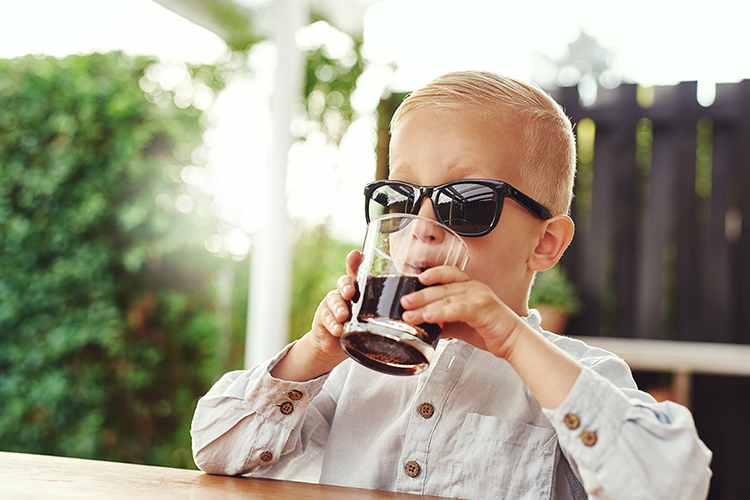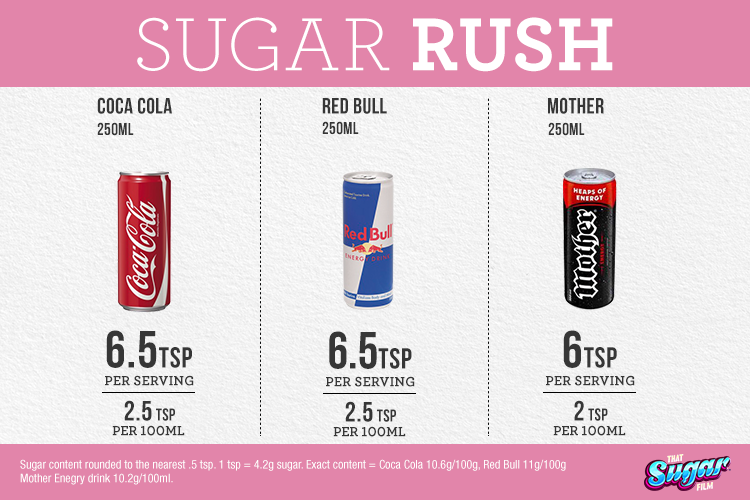Blog
Energy drinks and our kids – what’s the deal?
Energy drinks are deemed pretty cool, right? With the likes of Red Bull sponsoring extreme sport athletes, Mother (owned by Coca cola) sponsoring V8 supercars, and V (owned by Frucor) having sponsored the reality TV extravaganza, I’m a Celebrity, Get Me Out of Here, there is an association with these drinks fuelling you for extreme and exciting activity. But can a mere soft drink deliver such experiences? Mmm, likely not.
What are energy drinks?
Energy drinks are beverages that may contain taurine, caffeine, vitamins, herbal supplements, sweeteners and other ingredients. The main active ingredient in energy drinks is caffeine, with many containing 70 to 80 mg per 250 mL serve. That is three times that of coca- cola! (7)
It is important to note, the size of the Coke, Red Bull and Mother drinks are the SMALL size, at 250ml. Coke is commonly drink in 375ml cans. Mother is usually sold in 500ml size DOUBLING the amount of caffeine and sugar (and everything else) being ingested. That is a huge load on the body and brain.
Amping up the caffeine
Excessive caffeine consumption comes with an array of negative health effects in adults and young people. When combined with other ingredients found commonly in energy drinks, their consumption should be cause for alarm.
Caffeine is one of the central ingredients in an energy drink, included to ‘give you wings’ so to speak. In the US, adolescent caffeine intake averages 60 – 70 mg/day and ranges up to a shocking 800mg per day! (6;8) That is a sure fire way to get the heart rate up and the hands trembling.
It is been shown that caffeine consumption between 4-12mg per kilogram of body weight is associated with undesirable symptoms, including anxiety and jitteriness. (3) To put this into context, at a minimum, a 10-year-old, 30kg child consuming 4mg/kg of body weight will likely start experiencing anxiousness and feeling agitated part way into the second can of Red Bull (which has 77mg of caffeine). Is that really what a kid needs?
Energy drinks are consumed by 30% to 50% of adolescents and young adults. (7) The amount of caffeine consumed from energy drinks or energy shots was calculated for New Zealand children, teenagers and young men. (9) A shocking 70% of children and 40% of teenagers who consumed them were estimated to have exceeded the adverse effect level of ~4 mg per kilogram of body weight per day beyond their baseline dietary caffeine exposure.
And what this measurement doesn’t account for is the additional impact of sugars and other ingredients concurrently drunk with the caffeine in energy drinks.
The wired child
Before we delve further into assessing the impact of energy drink consumption, it is important to understand the ramifications of caffeine consumption in children. It has been recommended that adolescent and child caffeine consumption should not exceed 100 mg/day and 2.5 mg/kg per day, respectively. (1;3;7)
Whilst some caffeine can improve attention, this may not outweigh the negative effects in children, such as:
- Increase in blood pressure
- Increase in sleep disturbances
- Decrease in attention once caffeine consumption has stopped
- Decrease in reaction time as caffeine dose increases
- Possible impact on the developing child’s brain reward and addiction center, affecting future food and beverage preferences (and may be gender specific). (2;3;4;5;8)
The impact of energy drinks
Physical effects following energy drink consumption are wide reaching. In Germany, energy drink related incidents have been recorded since 2002. Negative impacts include:
- liver damage
- kidney failure
- respiratory disorders
- agitation
- seizures
- psychotic conditions
- rhabomyolysis
- tachycardia
- cardiac dysrhythmias
- hypertension
- heart failure
- death with overconsumption (7)
Between 2005 and 2009, the New Zealand National Poisons Centre recorded 20 energy drink/shot related incidents with reported symptoms such as vomiting, nausea, abdominal pain, jitteriness, racing heart and agitation. (9)
In children, adolescents and young adults, energy drinks have been linked to adverse effects such as diabetes, cardiac abnormalities, mood & behavioural disorders, seizures, or those who take certain medications. (7)
None of these effects are pretty, and can be downright scary to experience.
Regulation of energy drinks
Currently, there is no requirement for testing, warning labels, or restriction against sales or consumption of energy drinks to minors. (7) Energy drink manufacturers may circumvent the daily limit on caffeine by claiming that their drinks are ‘natural dietary supplements’. (7) Therefore, primarily the manufacturers make the safety determinations of energy drinks.
In contrast, over the counter caffeine stimulants such as NoDoz, containing 100mg of caffeine per tablet, must list minimum age for purchase (12 years), adverse effects, cautionary notes, recommended dose and the total daily recommended dose of caffeine. When a 500ml can of Mother contains 160mg of caffeine, plus other stimulating ingredients, it seems ludicrous there isn’t more restrictions around the purchasing of energy drinks by children, especially when adverse effects have been studied and reported.
Next steps
There is a campaign currently running to limit the selling of energy drinks to children under the age of 16 in Scotland, hopefully with positive results, and to be replicated elsewhere. At this stage, more research is required to better understand the maximum safe doses of energy drinks, the effect of their chronic use and their effect on children. For now, we could only recommend consumption of such drinks by children to a very minimum – or better yet, not at all.
References:
- Babu, K. M., Church, R. J., & Lewander, W. (2008). Energy Drinks: The New Eye-Opener For Adolescents. Clinical Pediatric Emergency Medicine, 9(1), 35–42. http://doi.org/10.1016/j.cpem.2007.12.002
- Bancalari, E. (2006). Caffeine reduces the rate of bronchopulmonary dysplasia in very low birth weight infants. The Journal of Pediatrics, 149(5), 727–728. http://doi.org/10.1016/j.jpeds.2006.08.038
- Heatherley, S. V., Hancock, K. M. F., & Rogers, P. J. (2006). Psychostimulant and other effects of caffeine in 9‐ to 11‐year‐old children. Journal of Child Psychology and Psychiatry, 47(2), 135–142. http://doi.org/10.1111/j.1469-7610.2005.01457.x
- O’Connor, E. (2001). A sip into dangerous territory. Monit Psychol.
- Oddy, W. H., & O’Sullivan, T. A. (2009). Energy drinks for children and adolescents. Bmj, 339(dec15 1), b5268–b5268. http://doi.org/10.1136/bmj.b5268
- Pollak, C. P., & Bright, D. (2003). Caffeine consumption and weekly sleep patterns in US seventh-, eighth-, and ninth-graders. Pediatrics, 111(1), 42–46. http://doi.org/10.1542/peds.111.1.42
- Seifert, S. M., Schaechter, J. L., Hershorin, E. R., & Lipshultz, S. E. (2011). Health effects of energy drinks on children, adolescents, and young adults. Pediatrics, 127(3), 511–528. http://doi.org/10.1542/peds.2009-3592
- Temple, J. L. (2009). Caffeine use in children: What we know, what we have left to learn, and why we should worry. Neuroscience & Biobehavioral Reviews, 33(6), 793–806.
- Thomson, B., & Schiess, S. (2011). Risk profile: caffeine in energy drinks and energy shots.













